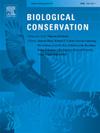Representations of human–elephant interactions on YouTube: Analyzing content and engagement to inform sustainable practices for wildlife tourism
IF 4.4
1区 环境科学与生态学
Q1 BIODIVERSITY CONSERVATION
引用次数: 0
Abstract
The viewing of free-ranging wildlife (especially those that are charismatic among the global public) remains popular as tourism, and it is important to monitor the impact of tourist activities on sustainability and animal welfare. It can be difficult to evaluate the impact of tourism on a broader scale, but a conservation culturomics approach may gather relatively large datasets consisting of user-generated content (e.g., social media) that reflect human–nature interactions. We utilized a sample of YouTube videos (n = 479) to characterize patterns in content and engagement of content representing human–elephant interactions in Sri Lanka. Beginning in 2009, we found a growing number of YouTube videos related to wild elephant tourism in Sri Lanka, with most videos (90 %) containing footage from protected areas. However, the prevalence of videos depicting stress behavior by elephants also increased over time. Stress behavior was more commonly observed in non-protected areas, and along with human-directed aggression, it was associated with proximity to people and human-initiated interactions. Video engagement was associated with several factors, including the number of channel subscribers, location, and human visibility and proximity. Together, these results demonstrate the potential of, and challenges associated with, wild elephant tourism in Sri Lanka serving conservation purposes, which may be representative of nature-based tourism that involves free-ranging populations of charismatic, flagship species around the world. Further studies utilizing a diversity of methodologies and involving a range of stakeholders will elucidate the impact of tourism on the sustainability of natural landscapes and the wellbeing of individual animals.
YouTube上人象互动的表现:分析内容和参与,为野生动物旅游的可持续实践提供信息
观看自由放养的野生动物(特别是那些在全球公众中具有魅力的野生动物)仍然是受欢迎的旅游,监测旅游活动对可持续性和动物福利的影响是很重要的。在更大范围内评估旅游业的影响可能很困难,但保护文化方法可以收集由用户生成的内容(例如,社会媒体)组成的相对较大的数据集,这些数据集反映了人与自然的相互作用。我们利用YouTube视频样本(n = 479)来表征斯里兰卡代表人象互动的内容模式和内容参与。从2009年开始,我们发现越来越多的YouTube视频与斯里兰卡的野生大象旅游有关,其中大多数视频(90%)包含保护区的镜头。然而,随着时间的推移,描绘大象压力行为的视频也越来越普遍。压力行为在非保护区更常见,并且伴随着人类导向的攻击,它与接近人类和人类发起的互动有关。视频参与与几个因素有关,包括频道订阅者的数量、位置、人的可见性和接近性。总之,这些结果表明了斯里兰卡野生大象旅游的潜力和相关挑战,以保护为目的,这可能是自然旅游的代表,涉及到世界各地有魅力的旗舰物种的自由放养种群。利用多种方法和涉及一系列利益相关者的进一步研究将阐明旅游业对自然景观可持续性和个体动物福祉的影响。
本文章由计算机程序翻译,如有差异,请以英文原文为准。
求助全文
约1分钟内获得全文
求助全文
来源期刊

Biological Conservation
环境科学-环境科学
CiteScore
10.20
自引率
3.40%
发文量
295
审稿时长
61 days
期刊介绍:
Biological Conservation is an international leading journal in the discipline of conservation biology. The journal publishes articles spanning a diverse range of fields that contribute to the biological, sociological, and economic dimensions of conservation and natural resource management. The primary aim of Biological Conservation is the publication of high-quality papers that advance the science and practice of conservation, or which demonstrate the application of conservation principles for natural resource management and policy. Therefore it will be of interest to a broad international readership.
 求助内容:
求助内容: 应助结果提醒方式:
应助结果提醒方式:


